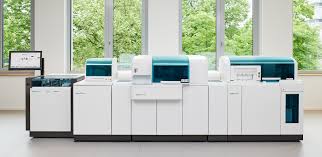24 June 2024 | Monday | News

Picture Courtesy | Public Domain
Roche announced the launch of its new analytical units, cobas® c 703 and cobas® ISE neo, for the cobas® pro integrated solutions, in countries accepting the CE mark. The cobas pro integrated solutions is a scalable and modular diagnostic platform designed for high-volume laboratories. The cobas c 703 and cobas ISE neo analytical units offer cutting-edge features to help address some of the key challenges faced by diagnostic laboratories worldwide such as shortage of qualified staff and space limitations.
“Today more than ever, accurate and timely diagnostics is critical for effective delivery of healthcare. Labs are under increasing pressure to process more samples, at greater speed without compromising on accuracy,” said Matt Sause, CEO of Roche Diagnostics.“With the launch of the cobas c 703 and cobas ISE neo, we are taking our latest generation clinical chemistry and immunochemistry platform, the cobas pro integrated solutions, to the next level. By integrating high-volume clinical chemistry testing and increased automation, we will set a new standard for high volume testing in the clinical lab.”
cobas c 703 analytical unit
The new cobas c 703 analytical unit is designed to double the clinical chemistry throughput on cobas pro integrated solutions, offering up to 2,000 tests per hour and 70 reagent positions. This increased onboard reagent capacity means more high-value tests can be performed whilst improving workflow efficiency and saving time spent reloading reagents. This new unit will minimise operator maintenance to once a month, increasing uptime for laboratories.
cobas ISE neo analytical unit
The cobas ISE neo is designed to improve ion selective electrode (ISE) testing efficiency, offering up to 1,800 tests per hour. With a number of innovative hardware and software features, including an automated calibration concept, it significantly reduces the need for manual intervention. It also performs more tests per reagent bottle, reducing the frequency of bottle changes, minimising plastic waste, and reducing logistical efforts compared to previous generation systems.
By automating work that would have been done manually in the past, these new units further improve lab efficiency, thus addressing the shortage of qualified staff and increasing the volume of tests that can be delivered to the people who need them most.
© 2025 Biopharma Boardroom. All Rights Reserved.